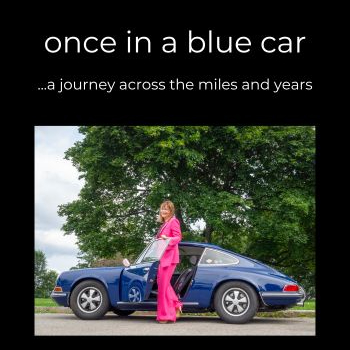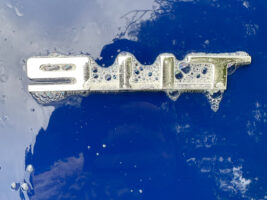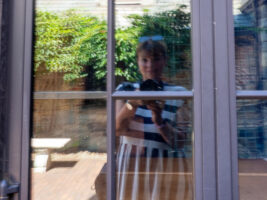The Blue Car helps initiate conversations at gas stations, at trailheads, in parking lots. I hear a lot of “cool car,” and “that car is sick” (my favorite). Most people ask the year (I always make them guess).
Then there are people I meet who imply I am being irresponsible…that I am not properly caring for this precious vintage automobile. “That car needs to be in a garage!” “You are crazy to be driving that car…it needs to be under wraps somewhere.” “Aren’t you devaluing that car by driving it cross country?”
If you read “The Journey” you know that while I never mothballed the Blue Car, for a long time after my husband died in 1999, I drove it very little. I had young children and needed a bigger auto on most days and the Blue Car didn’t feel like my car. But in all those years, I did drive it…I never considered it a museum piece. This was true even after it came back from a partial restoration in 2018 and the exterior was pristine and gorgeous and the thought of making a mark on that finish was unbearable. But it helped that the interior was mostly the same it had ever been. The squishy seats, faded dash controls, and worn steering cover helped me think about the car as something to drive and not something to be put away and protect.
And then, a few weeks ago, in the snow and ice at Bryce Canyon National Park, a man walked by me and said, “Lady, if that was my car, it would be locked away. I would never drive it.” He didn’t even have the good manners to say “good morning,” or “sick car.” He just shook his head in disgust and was in his car and gone before I had a chance to reply.
As I watched him pull away, two words popped into my mind — good china — those precious porcelain objects that instill more fear and caution than joy in many of us. I know people who have never unwrapped their porcelain wedding gifts, never used great grandma’s dinner set. I have always had mixed feelings about these fancy dishes that get used a few times a year at best. On the one hand, when the good china is on the table, it is a reminder that it is a special occasion. On the other, it seems a shame to not use these beautiful and meaningful things more often.
But there are risks to frequent use of our beautiful, precious, and sometimes valuable possessions. I knew before heading out on this road trip in September, knew even when this journey was just a glimmer of an idea, that I couldn’t think of the Blue Car as good china if I was going to really do this trip right. I knew I had to steel myself for bad things; it seemed unlikely I could drive this car for four months over thousands of miles and come back with a pristine paint job. And sure enough, barely two weeks into the trip, while happily driving along the Bluegrass Parkway in Kentucky, I came upon road works and with no exit in sight, I had nowhere to go but forward. Asphalt machines were spewing their asphalt, sprayers were spraying their spray, and I heard gravel hitting the car and just held my breath and drove through it. You know I pulled over at the first exit. It wasn’t as bad as I thought…a few tiny marks. But I will admit it took me a good half a day to get over it (ok…maybe a full day), even with the help of some very nice bourbon in Bardstown that evening.
But get over it I did and surprisingly, I even had some sense of relief that it was done, that the first marks were made. Those gravel roads I drove to get to the Keys Ranch in Joshua Tree National Park and that vineyard off the beaten path in Oregon? Piece of cake. Kentucky did me a favor. I have become intrepid in the Blue Car (within reason) which means this trip is exactly what I want it to be and I am not held back by worries about the Albert Blue paint job.
That man at Bryce Canyon looked at the Blue Car and saw good china. He’s allowed his opinion but luckily, it’s my car and I decide. The thing is, there are many stand ins for good china in our lives. It could be that bottle of very old single malt that sits on the shelf because it was so expensive and it is so rare, the heirloom necklace or watch that is locked away, or those nice crystal wine glasses stored on the back of the shelf for fear they will get broken. I even know someone who wraps the open page of his cookbook in saran wrap so cooking stains won’t mar the pages while he’s baking. Oh, if you only saw my cookbooks! They are a mass of stained pages and notes from first meals made. I can tell you that a certain maroon stain came from the first time I made Beef Wellington and dribbled port across the page while making the mushroom reduction sauce, and you can tell from the challah recipe, on the loose page in the Silver Palate Cookbook, that I made that bread a lot before I memorized the recipe. I LOVE this about my cookbooks and my kids do too. I even write on the pages the first time I make something, noting who was at the meal, the date, and what we all thought. My cookbooks are a record of my life through the feasts and trials and errors I have made in the kitchen. And I love that one of my kids will open a recipe and read the notes, see the stains, and the memories come flooding back. Memories of meals and laughter and joy.
When we save things, when we protect them, when we keep them pristine, what are we waiting for? What are we worried about? Don’t our daily lives deserve beauty? Isn’t it ok for all of our possessions to acquire the patina of full days and lives well lived?
Someday, will my sons and my daughter get more enjoyment from inheriting a car I didn’t drive, full of worry about damaging its pristine paint? Or will it give them more joy and laughter to take the Blue Car out on the road, knowing that I enjoyed a most glorious four-month road trip in it (and hopefully many more) and knowing those chips in the paint came from Kentucky where I had a great four-day bourbon tour and got over it?
I have always surrounded myself with things that are imbued with memories and stories. Perhaps that’s why I got over those chips pretty quickly on the Bluegrass Parkway, and perhaps that’s why I do use the good china. Those precious hand-painted porcelain plates are right at hand on the sideboard in the dining room and I often pull them out when I am having breakfast or lunch alone. The food always tastes better no matter how simple the meal…all of my senses are engaged when I eat from those plates and memories flood back of why I picked them (studying in Copenhagen), how I have acquired them (one at a time in antique shops and online in the last decade), and all the meals shared (so, so many).
I think it is no accident that I have been thinking of the Blue Car, good china, and yes, even my marked up and messy cookbooks these last few weeks of this road trip. This morning, I saw that I almost have 13,000 miles logged thus far and I feel a deep sadness that the adventure is almost over– I will be back home in ten days’ time. In these last few weeks I have pondered how to hold onto the magic of this trip, knowing nothing at home with replicate this daily feeling of freedom, wonder, and adventure. But I have come to fully embrace what I have known for a while now—that the Blue Car is a metaphor for something much bigger than this road trip. It’s about acquiring a patina from a life lived with gusto and lack of trepidation. And I am determined, when this road trip ends, to remain in a Blue Car state of mind.
Susan Silberberg, mile 202,702




